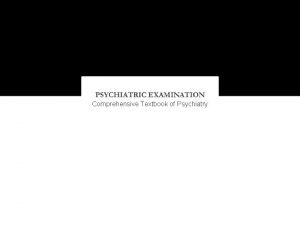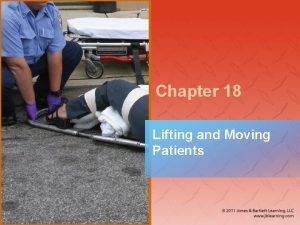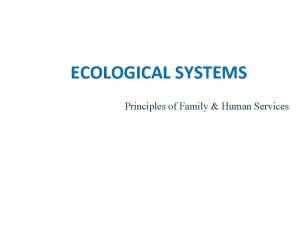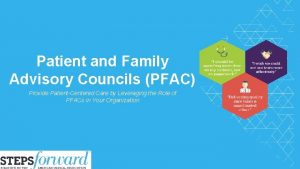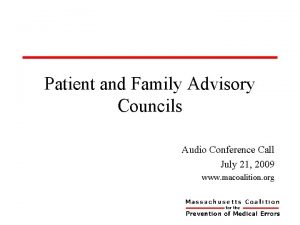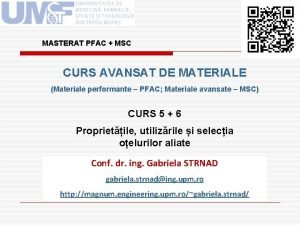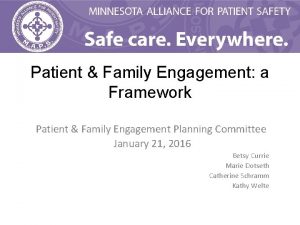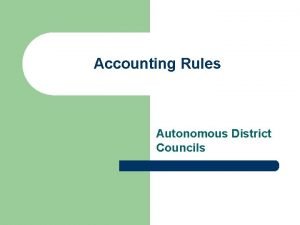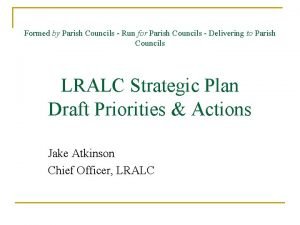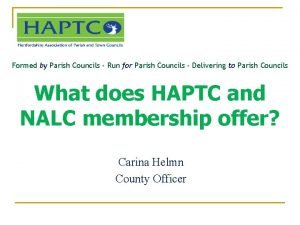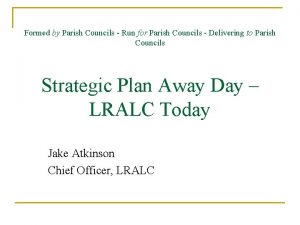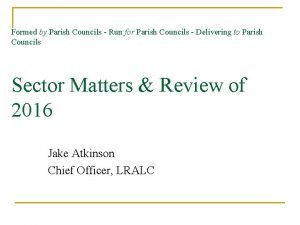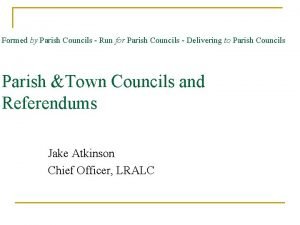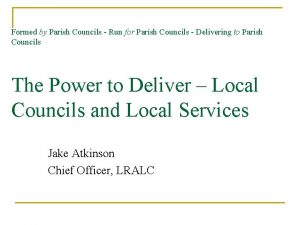Patient and Family Advisory Councils PFAC Core Principles

















- Slides: 17

Patient and Family Advisory Councils (PFAC) – Core Principles 2017

Patient & Family Engagement is Valued Leadership Must be Engaged Organizational Readiness is Key Ongoing Planning & Review is Imperative Recruitment Strategy is Essential Engagement of Patient-and-Family Advisors (PFA) is Vital Ongoing Feedback & Member Evaluation are Crucial Successful PFACs Improve Quality Measuring the Impact of PFACs is Important 2

Patient & Family Engagement is Valued Essential perspective that is not only heard, but integrated into service and QI to advance high quality, person-centric care Strategy Insights • Use existing groups (e. g. readmissions, specialty populations, chronic care clinics, volunteers) • Leverage community connections, e. g. navigators, community health workers • Culture of safety results Resources Michigan Health and Hospital Association Keystone Center, A road Map to Patient and Family Engagement, 2015. 3

CMS: Priority Objective Active patient & family partnership at 3 key organizational levels: ü Point of Care ü Policy and Protocol ü Governance 4

• Very critical step in ensuring success of the PFAC • Model & foster consensus towards value in activating patient/family partnership as essential component of health care operations Strategy Insights • Meet with leadership individually & as staff groups to reinforce PFAC goals & benefits and share realistic implementation needs, e. g. resource commitments • Clearly define the value of the PFAC to the organization • Address privacy or policy concerns early in the process • Identify long-term and short-term goals w/clearly defined metrics & outcomes 5

Getting Started 1 – 4+ Months Forming the Council 4 – 7+ Months Developing the Program 7 – 9+ Months 6

• Ensure that all understand the magnitude of change required for a committed partnership w/ patients/families • Goal is to embed the PFAC into organizational culture Strategy Insights • Involve leadership in the assessment process • Identify and discuss barriers - dispel myths • Be prepared to explain how the PFAC will improve the organization and how success will be measured Resources • AHA & Institute for Family-Centered Care, A Hospital Self-Assessment Inventory 7

• Progressive phases: Prepare, Plan & Launch • Consistent thread across each - move toward enhanced PFE & Quality Improvement to favorably impact optimal health outcomes Strategy Insights • Select a PFAC coordinator - support individual w/policy & dedicated resources • Assemble team to develop a mission statement/charter/operating guidelines • Determine PFAC structure • Determine PFAC Chair or Co-Chairs Resources • NICHQ, Chartering Your PFAC: Purpose and Structure 8

Recruitment Strategy is Essential • Membership should reflect patients & families served by the organization • Training, on-boarding & exit plans are required for members • Determine clear expectations for participation Strategy Insights • Create a recruitment plan • Find the right people • Ensure diversity Tools • NICHQ, Characteristics of Effective Family Advisors • AHRQ, Sample PFAC Orientation Manual 9

Engagement of PFAs is Vital • Recognize that membership may evolve over time • Invest in your organization’s Patient-Family Advisors Strategy Insights • Allow PFAs to offer suggestions for agenda topics • Provide genuine opportunities for input • Exercise the power of storytelling • Start small – build trust, focus on system breakdowns rather than individual mistakes • Create an environment for feedback Tools IPFCC, Sharing Personal and Professional Stories 10

• Assess effectiveness of meetings • Close the feedback loop – provide results and recommendations Strategy Insights • Meeting evaluation • Annual advisor selfreflection of participation and experience • Identify what the organization has learned from patients and families 11

Successful PFACs Improve Quality • Embed the PFAC into the organizational culture • Establish clear goals and measure success Strategy Insights • Build the PFAC into strategic planning & quality lifecycles • Consider use & implementation of the PFAC across the continuum of care • Align council activities with organizational and national quality and patient safety priorities • Continually monitor PFAC structure, process and outcome measures to provide value 12

Measuring the Impact is Important • There is much opportunity for improvement in this area • Current focus is on process metrics – need to move towards outcomes Strategy Insights • Show PFAC work has impacted outcomes • Measure the impact of the project on patient, provider, and council member satisfaction 13

Percentage of all U. S. hospitals meeting each metric Percentage of Illinois hospitals meeting each metric* 48. 9% 73. 2% 90% 3. PFE leader or function area exists in the hospital 56. 1% 65% 4. PFE committee or representative on hospital committee 50. 4% 63% (hospital governance) 41. 1% 63% At least 3 of the 5 55. 5% 77% At least 4 of the 5 36. 9% 62% All 5 metrics 18. 4% 37% 2016 PFE Metric 1. Planning checklist for scheduled admission 2. Shift change huddles/bedside reporting with patients and families 5. Patient and family on hospital governing and/or leadership board

Additional Resources • Agency for Healthcare Research and Quality, Working with Patient and Families as Advisors. • American Hospital Association, Health Research & Educational Trust, A Leadership Resource for Patient and Family Engagement Strategies. • Centers for Medicaid and Medicare Services (CMS), Partnership for Patients Strategic Vision Roadmap for Person and Family Engagement. • Institute for Patient-and-Family Centered Care (IPFFC), Creating Patient and Family Advisory Councils. • Illinois Health and Hospital Association, A Road Map to the Successful Implementation of Patient and Family Advisory Councils. 15

Additional Resources • Michigan Health and Hospital Association Keystone Center, A road Map to Patient and Family Engagement, 2015. • Planetree: Global Leader in Advancing Person-Centered Care. • University of Wisconsin Health, Patient & Family Advisory Partnership Program. • Webster, P. D. , Johnson, B. H. , Developing and Sustaining a Patient and Family Advisory Council, Bethesda, Maryland, Institute for Patient and Family Centered Care, 2000. Print Only. • West, M. , Brown, Laurie, A Toolkit for Creating a Patient and Family Advisory Council, BJC Healthcare. 16

 Best practices of catholic pastoral and finance councils
Best practices of catholic pastoral and finance councils 2nd buddhist council
2nd buddhist council Derbyshire association of local councils
Derbyshire association of local councils Sa councils
Sa councils Indian councils act of 1861
Indian councils act of 1861 Customer councils
Customer councils Patient 2 patient
Patient 2 patient The brittle, rocky outer layer of earth
The brittle, rocky outer layer of earth The strong lower part of the mantle
The strong lower part of the mantle Core rigidities
Core rigidities Patient family
Patient family What are the 3 main layers of the earth? *
What are the 3 main layers of the earth? * Five core principles of money and banking
Five core principles of money and banking Five core principles of money and banking
Five core principles of money and banking Lifting and transporting patients
Lifting and transporting patients Ems lifting techniques
Ems lifting techniques Conjugal family
Conjugal family Exosystem
Exosystem










